Thank you for your interest in participating as a Feeder Watcher for the Christmas Bird Count (CBC). The data you collect will help to broaden our understanding of winter bird habits. The goal of the CBC is to census every bird within a pre-defined, 15-mile diameter circle over a 24-hour period. The Feeder Watch portion of the CBC aims to determine the highest number of individuals of each species seen on the bird feeders in your yard. Download a count tracker here.
To be a Feeder Watcher, you must meet the following criteria:
- Your bird feeder/yard must be located within the a designated CBC circle. Review this map to confirm that your planned Feeder Watch location is within a count circle.
- We unfortunately cannot use data from feeders located outside the count circle, but observations would still be valuable to eBird.
- You may only count birds at your feeder on the day of the bird count in your circle.
Additional information about the CBC is available at Audubon Society of Western Pennsylvania’s website, aswp.org
Tips for Identifying Birds:
Cornell Lab of Ornithology has several ID resources available through itsProject FeederWatch program . Audubon also offers a free mobile app for bird ID available here.
Tips for Counting Birds:
When counting at a bird feeder, record only the highest number of birds per species seen at any given time. Here is an example of how to eliminate the possibility of counting the same individual bird repeatedly: if there are two Blue Jays at your feeder, note those two jays for your count. The birds will fly away and a single Blue Jay may land later. Do not add this ’new’ jay to your count because it may be one of the same jays from earlier. The only way that the number of jays counted could increase would be if more than two Blue Jays (3+) landed at the same time at your feeder. Please follow this rule for each species that you see at your feeders.
Submitting Count Numbers Using eBird:
Feeder Watch observations may be recorded using eBird if you are already familiar with the service. You must create a new list each time you start observing your feeder and stop the list each time you finish observing. All lists created must then be shared with the group set up by your Count Circle Leader, following the instructions at this link.
Submitting Count Numbers Using the Datasheet:
The datasheet on the second page of this document can be used instead of eBird by filling out the following information:
- Observers: The name of all people that took part in your Feeder Watch count.
- Feeder Location: The physical address of the feeder(s) being observed.
- Time: The total number of hours (to the nearest quarter) spent observing your feeders.
- Species: Select the correct species from the list of most common backyard birds.
- Number: Using the instructions above, record the maximum number of each species at one time.
This information is courtesy of Birds Connect Seattle/Seattle Audubon; updated to reflect the birds of Western Pennsylvania. Visit birdsconnectsea.com for the original sheet.
14th Annual South Butler CBC-December 29, 2024
Weather Conditions 48 F to 64F, cloudy with off and on rain showers in the morning. Blustery conditions in afternoon as the circle was under a High Wind Advisory.
The 14th annual South Butler Bird Count was held this year on a Sunday, December 29, 2024 on a warm, rainy, and windy day. Temperatures ranged from 48 to an outright balmy 64 degrees F, with strong winds in the afternoon. We were under a High Wind Advisory, and that as well as the warmth and rain dampened the number of birds observed.
The South Butler CBC count circle incorporates the south-central and western portions of Butler County, including a small amount of Allegheny County, with the circle centered at Callery, PA. This count includes rapidly developing portions of Cranberry, Seven Fields, Adams Township, in Butler County, and Marshal, Bradford Woods, and Pine Township in Allegheny County. Contrasted in the middle and northern portion of the circle is more rural farms, fields, and forests, in Penn, Forward, and Jackson Townships along with a key waterway the Connoquenessing Creek.
This year 36 birders battled the rain and wind and were divided into 16 “field parties” and assigned specific locations to count. The total driving miles of the count was 143.1, total walking miles counting birds was 44.2. Total hours in the field equated to 56.7. We also had 24 feeder counts with 26 observers with the circle contributing their observations.
61 total species were found, including 6,737 individual birds counted. This represents four species more than the long-term average (57) but a continued general downward trend of individual birds observed the past several years (though slightly more than last year’s 6,613); specifically down from the high of 10,487 total birds observed in 2016.
As it has been every year of the previous counts the most abundant species was the invasive European Starling (1,463). The other Top 9 species falls closely in line with what the count has observed the previous 13 years with species that have close connection with human-altered environments. Two of the top ten are introduced/invasive species (European Starling and English House Sparrow). Canada Geese, Robins, and Mourning Doves have all been in top
list of birds observed since 2016.
Northern Flickers crushed their previous high count (19), set just last year, with 28 observed in this year’s CBC. There is a clear upwards trend of this woodpecker species in the count. Same goes with Turkey Vultures. A bird rarely observed in Butler County prior to 2016, with 6 birds doubled the previous record set in 2016. Wild Turkey tied their previous high of 125 (2016) Both American Tree (45) and White-throated (107) Sparrows were tied for their second highest totals recorded previously; only surpassed by 2017.
On the other end of the spectrum, we tied the lowest count of Pileated Woodpeckers (5) and the lowest ever (2) for Cedar Waxwings. The former may very well be undercounted the count day due to the weather, while the latter is a known boom or bust species based on winter food availability. Zero Field Sparrows were recorded, marking a quick and steady decline in the SB CBC since it was established in 2012.
Raptors continued to do well in the circle. American Kestrel made a nice showing (13) after previous year declines. Red-tailed Hawks (31) surpassed the 23 counted in 2023. Accipiters like Cooper’s (9) and Sharp-shinned (0) Hawks also showed a slight decline from previous years, but I mostly account this to weather. On a positive note, we found our largest number of Bald Eagles recorded (5) up from last year’s 4. This species continues to repopulate its former range in Western Pennsylvania, after an absence of at least 100 years.
The highlight birds of this year’s count was a lone adult male Northern Harrier, observed slowly headed south of the Connoquenessing Creek in Forward Township, 2 Pine Siskins and a single Grey Catbird in the SE section of the circle.
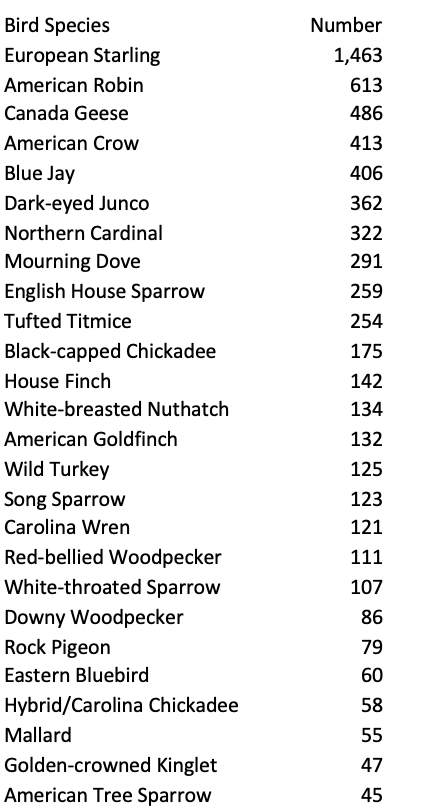

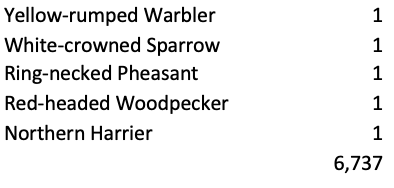
2024 Mon Valley Christmas Bird Count: December 15, 2024
54 species of birds counted [51 in 2023]
3,371 individual birds counted [2,322 in 2023]
35 total participants [47 in 2023]
39.50 total party hours (including day time birding, owling, and feeder watching)
90.25 total party miles (includes walking, driving, and cycling)
Top 5 species by number were:
American Crow
American Robin
European Starling
Northern Cardinal
Canada Goose
Read the full report here.
124th Pittsburgh Christmas Bird Count Summary
Two hundred and fifteen observers participated in the Pittsburgh Christmas Bird Count on December 31, 2023.
Weather for count day was mild and rainy. This has become the norm for this count, it seems. The temperature ranged from 36 to 40 degrees at the count’s geographic center in Shaler Township. Water was unfrozen on all lakes, rivers and streams.
The weather was less than ideal for a bird count. As in previous years, it was noted that birds were seemingly capable of finding plenty of natural food sources because of the mild weather, therefore feeder count numbers were lower than expected. Despite the rain, 76 species were found on the count, bettering our 10-year average by three species.
A total of 39,946 birds were counted on count day. Interestingly, this is just 50(ish) birds shy of last year’s individual total. For the most part, birds were detected near their expected numbers. But a few species were found in high numbers – their highest in recorded history during this count. These include Red-winged Blackbird (81) and Killdeer (21), both species with traditional winter ranges just slightly south and/or east of Pittsburgh. One would assume that these are in response to mild winter weather. Golden-crowned Kinglet (110) was also found in its highest abundance. The number of Field Sparrows observed tied its previous high count, as did Common Raven (9), Hairy Woodpecker (93) and Northern Flicker (85). Finally, a Red-headed Woodpecker was found for only the sixth time on count day.
Audubon Society of Western PA would like to thank each of the participants that contributed to the count this year. We are thankful that you joined us! A special thank you to the area leaders who help to compile bird numbers and participant information. Their work makes compiling the data for the count much easier, and undoubtedly more accurate.
The 13th annual South Butler Christmas Bird Count (124th nationally) was held this year on a Sunday, December 31st, 2023 on a cloudy yet seasonable winter day. Temperatures ranged from 34-37 degrees F with light snow showers to light rain in the late morning and afternoon.
The South Butler CBC count circle incorporates the south-central and western portions of Butler County, including a small amount of Allegheny County, with the circle centered at Callery, PA. This count includes rapidly developing portions of Cranberry, Seven Fields, Adams Township, in Butler County, and Marshall, Bradford Woods, and Pine Township in Allegheny County. Contrasted in the middle and northern portion of the circle is more rural farms, fields, and forests, in Penn, Forward, and Jackson Townships along with a key waterway the Connoquenessing Creek.
This year, 66 intrepid birders braved the cold and were divided into 21 “field parties” and assigned specific locations to count. The total driving miles of the count was 108.4, total walking miles counting birds was 46.3. Total hours in the field equated to 54.7. We also had 25 feeder counts with 30 observers with the circle contributing their observations. We also held a separate “Kids CBC” that is led by ASWP environmental educator Ryan Stauffer. The Kids count is geared towards getting younger children and families involved in birds, nature, and being an active participant in community science. This year 27 children and families helped survey the park. Total participation this year was an all-time high of 123 counters.
59 total species were found, including 6,613 total birds counted. This represents two species more than the average (57) but a general downward trend of individual birds observed the past several years; specifically down from the high of 10,487 total birds observed in 2016. Given the record number of counters that does give us some pause; however, much of the decline could also be due to European Starling decline, weather conditions, and natural cycles of food availability. But the long-term trend deserves watching.
As it has been every year of the previous 13 counts the most commonly counted species was the European Starling (1,574). The other Top 9 species falls in line with what the count has observed the previous 13 years with species that have close connection with human-altered environments.
Raptors are generally doing well in the circle, but we have observed a general decline in some species. After a record count of Red-tailed Hawks recorded (80) in 2018 to only 23 this year. American Kestrel showed a continued general decline both in the count circle and across their
range as a whole with only 5 counted. This is a target species of the count and have shown a general decline since the count first began. Accipiters like Cooper’s (9) and Sharp-shinned (3) Hawks also showed a slight decline from previous years. On a positive note we found our largest number of Bald Eagle’s recorded (4) and Red-shouldered Hawks rounded out the raptors with a count high (6) while we observed (1) Turkey Vultures this year.
Interestingly, fruit eaters like American Robins were up (791) and Northern Flickers (19-a high count) were up while Eastern Bluebirds (23) Cedar Waxwings (16) numbers dropped substantially to previous years. The latter two tend to fluctuate in numbers year to year within our count circle.
Several sparrow species did well, especially White-throated Sparrows (141) and Song (124)-both count highs, while Dark-eyed Junco (388) were the 5th most counted species. However, as experienced across their range American Tree Sparrow (18) showed a continued steady decline while zero Field Sparrows were recorded. White-crowned (2), Fox (1), and Swamp (1) continue to be detected annually in small numbers.
Winter migrants like Golden-crowned Kinglet (41), Winter Wren (5) were count highs, and while Brown Creeper (7) and Purple Finch (2), Yellow-bellied sapsuckers (2) were observed at count average as well. For the first time in 6 years zero Red-breasted Nuthatches were observed.
Highlight species of the count included count high observations of Grey Catbird (2), our continuing resident population of Red-headed Woodpecker (1), and a high count of Belted Kingfisher (13!). Interestingly (and surprising) given the warm December and completely open water no other waterfowl species were detected in the count circle. And given the warming of our climate during our winters over time, we continue to see a northward push of Carolina/hybrid Chickadees into the count circle, at the expense of the Black-capped.

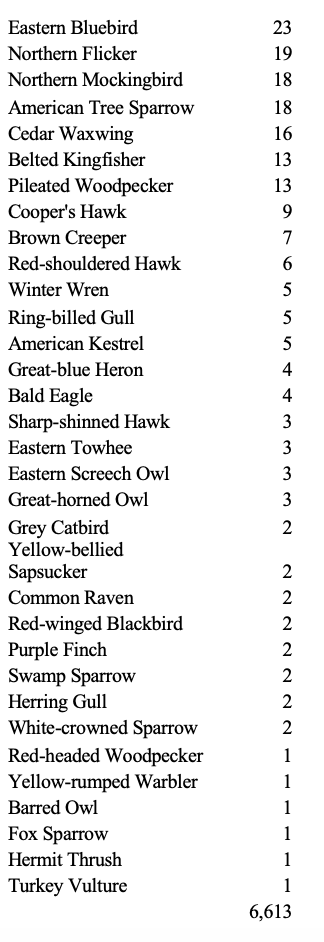
Mon Valley Christmas Bird Count: 2023 Wrap Up
For the 2023 Christmas Bird Count (CBC), Audubon Society of Western Pennsylvania (ASWP) added a new Mon Valley CBC circle. This 15-mile diameter circle is centered in the McKeesport/White Oak area and offers residents an opportunity to join in on this long-standing Citizen Science project. This new CBC circle compliments ASWP’s Mon Valley Bird-Friendly
Community Project, – a collaborative initiative focused on enhancing\ access to nature, improving environmental health, expanding environmental education, and enhancing habitat for birds and pollinators.
Stormy weather was a concern going into the inaugural Mon Valley CBC on Sunday, December 17. Fortunately, the temperatures and rain stayed on the mild side during the daylight hours, with a high of 54 and a low of 45. Although the skies looked threatening, the rain did not fully arrive until the evening, so participants enjoyed an overcast but pleasant day counting birds.
Despite the forecast and first-year status, 47 people joined in to count birds and 40 checklists were submitted. Throughout the day, 2,322 individual birds were counted, with 51 different bird species observed. Counting was done on foot, by car, and even by bike on the GAP trail. Since this was the first year, there is no data to compare these numbers to, but it will be interesting to see how these numbers will change in the years to come. ASWP offered two group walks at Pleasant Valley Park in Murrysville and Renziehausen (Renzie) Park in McKeesport. Two additional walks were offered by partners Allegheny Land Trust at Dead Man’s Hollow and Allegheny County Park Rangers at White Oak Park.
The most common bird observed was the American Robin with 318 individuals counted. Some highlights for the day include four Common Ravens seen along the Monongahela River, and a Merlin that posed for a group of photographers during the Renzie Park group walk. Counters also heard a Great Horned Owl calling and photographed an Eastern Screech Owl in a cavity of a black cherry tree.
Audubon Society of Western Pennsylvania would like to thank everyone who joined us for the first ever Mon Valley CBC. Special thanks go out to our partnering organizations, Allegheny Land Trust, and Allegheny County Park Rangers, as well as the news outlets that helped us promote the event. We hope that the excitement generated this year will continue on into 2024, and that the Christmas Bird Count will grow to become a cherished tradition in the Mon Valley area.
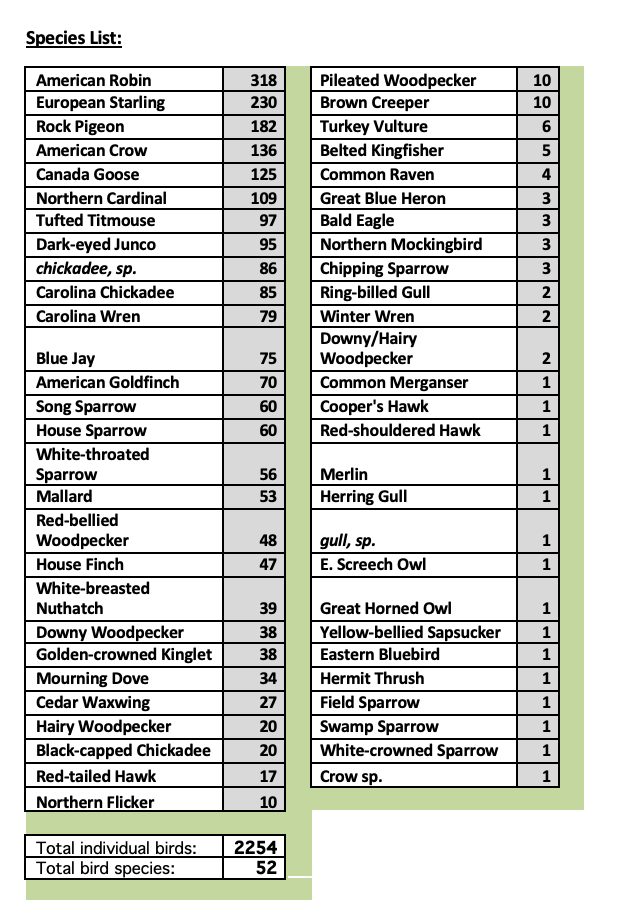
123rd Christmas Bird Count Summary for Pittsburgh
One hundred forty-nine field observers and thirty-six feeder watchers participated in the Pittsburgh Christmas Bird Count on December 31, 2022. The annual count is hosted and coordinated by Audubon Society of Western Pennsylvania and always occurs on the Saturday after Christmas.
Weather for count day was mild and rainy. The temperature ranged from 48 to 55 degrees at the count’s geographic center in Shaler Township. Water was frozen on all lakes, due to very cold temperatures just a week before, but rivers and large streams were generally open. Just chunk ice floating on the rivers.
The weather was less than ideal for a bird count. As in previous years, it was noted that birds were seemingly capable of finding plenty of natural food sources because of the mild weather, therefore feeder count numbers were low. Despite the rain, 75 species were found on the count, bettering our 10-year average by two species.
A total of 39.997 birds were counted on count day. For the most part, individual numbers hovered around their 10-year averages. Poor weather reduces visibility, ability to detect birds by sound, and also often decreases participant effort afield (meaning participants spend less time trying to find birds), so it is tough counting in these conditions. But, a few species were found in high numbers – their highest in recorded history during this count. These include Redhead (5), Common Merganser (55) and Canada Goose (1,716). The notable find this year was a Greater White-fronted Goose in Calvary Cemetery near Greenfield. This bird should be wintering in the gulf states. A Marsh Wren that had been documented wintering at Hartwood Acres was also tallied on count day.
The effort to tally American Crows was hugely successful this year. With some intel from area residents, our crow team positioned themselves at Duquesne University which provided an excellent vantage point. 20,000 crows were tallied as they returned to their roost.
Audubon Society of Western PA would like to thank each of the participants that contributed to the count this year. We are thankful that you joined us! A special thank you to the area leaders who help compile bird numbers and participant information. Their work makes compiling the data for the count much, much easier, and undoubtedly more accurate.
122nd Pittsburgh Christmas Bird Count Wrap-up
Pittsburgh Summary is below; please scroll down for the South Butler Bird Count information.
189 intrepid souls participated in the Pittsburgh Christmas Bird Count on January 1, 2022. The annual count is hosted and coordinated by Audubon Society of Western Pennsylvania and always occurs on the Saturday after Christmas.
Weather for count day was mild and very rainy. The temperature ranged from 40 to 50 degrees at the count’s geographic center in Shaler Township. Water was completely open on all lakes, rivers and streams, as temperatures were consistently mild during the days and weeks leading up to the count.
The weather was less than ideal for a bird count. Most field participants wore layers of rain protection and many wore wading boots afield. Birds were seemingly capable of finding plenty of natural food sources, and therefore feeder count numbers were low. 72 species were found on the count, matching our 10-year average.
A total of 16,197 birds were counted on count day. For the most part, individual numbers hovered at or just below their 10-year averages. Lower numbers are likely a result of the weather on count day. Poor weather reduces visibility, ability to detect birds by sound, and also often decreases participant effort afield (meaning participants spend less time trying to find birds). But, despite the weather, a few species were found in high numbers – their highest in recorded history during this count. These include Gadwall (4), Northern Raven (8), Ruby-crowned Kinglet (5), Swamp Sparrow (13) and Red-winged Blackbird (30). The notable find this year was an Orange-crowned Warbler visiting a jelly feeder in Oakland. Even more remarkable, the bird was found at the same feeder that produced an oriole last winter.
The weather greatly affected our ability to tally American Crows. In fact, this single species is
often responsible for one third of the “total birds” counted each year. The birds are typically tallied as they return to their roost at dusk. The dense fog made that count nearly impossible, thus, the crow tally fell to a 10-year low of 1858 individuals. The birds are still in much higher numbers at their roost; the count was just not able to depict the actuals.
As mentioned previously, overall feeder count numbers continue to be lower than normal. On the other hand, some field participants commented on “digging up” flocks of species
such as Dark-eyed Junco, Song Sparrow and American Goldfinch. It is possible that some birds, such as goldfinches are using natural resources farther into the winter these days, and returning to feeders only when forced by weather. It could also be possible that other birds, such as juncos, are not moving south as early in the season. Of course, these are only anecdotal comments. Regardless of the reason, American Goldfinch and Dark-eyed Junco were tallied at their lowest numbers in 10 years. Neither was far off of their previous low, but both were much lower than their 10 year averages (10 Year/Count: AMGO 460/325, DEJU 653/347). Hopefully this is just an indication of weather, or foraging strategies, as suggested.
Audubon Society of Western PA would like to thank each of the 189 participants that contributed to the count this year. We are thankful that you joined us! A special thank you to the area leaders who help compile bird numbers and participant information. Their work makes compiling the data for the count much, much easier, and undoubtedly more accurate.
Our numbers dropped this year over the past few CBC's. In 2020 we counted 7,624 individual birds (54 species overall), 2021 9,605 individual birds (55 species overall) and 2022 5,664 individuals (57 species overall).
Total birds: 5,664
Weather Conditions: Temperature falling, 39-32 degrees F.
Cloudy with spots of light drizzle in AM, snow flurries in PM. Lakes, ponds, and creeks 100% open and ice free. No snow on ground.
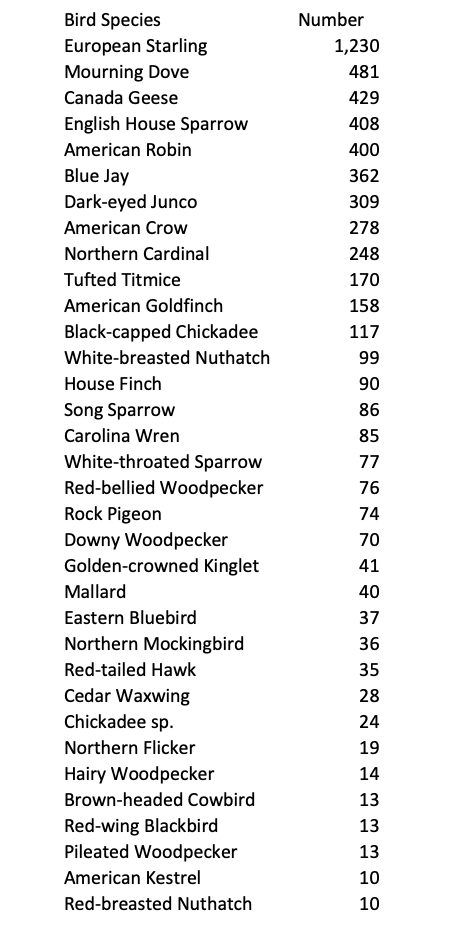
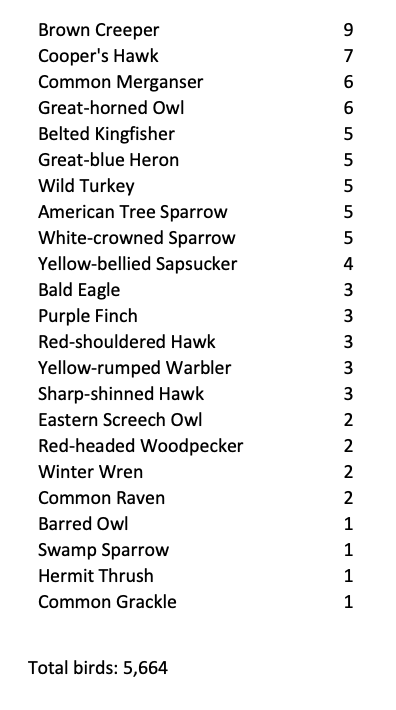

121st Pittsburgh Christmas Bird Count - 2020 wrap-up
Two hundred and sixteen hardy people participated in the Pittsburgh Christmas Bird Count on December 26, 2020. The annual count is hosted and coordinated by Audubon Society of Western Pennsylvania and always occurs on the Saturday after Christmas.
Count day looked a bit different than it had in previous years, because of the pandemic. All area leaders were instructed to eliminate gathering locations and group activities, and to ask participants to wear masks and social distance during the count, even while in the field. The pandemic probably pushed a few more participants indoors this year, 67 people watched feeders, but a whopping 174 still ventured outdoors for a portion of count day.
Weather for count day was cloudy and frigid. The temperature ranged from 14 to 22 degrees at the count’s geographic center in Shaler Township. It was breezy too, with wind speeds up to 15 miles per hour, which made it feel even colder. Open water was partly frozen, rivers and streams were unfrozen.
Despite being cold, conditions were ideal for the bird count. Snow blanketed the ground, making viewing conditions ideal. Overall species diversity was high, with 78 species found. Our 10-year average is 73. A few species are now regularly found, pushing our 10-year average upward.
These include almost annual Turkey Vulture, Northern Raven, Fish Crow, Eastern Towhee and Chipping Sparrow. Each of these were unlikely on this count just a decade ago.
A total of 24,522 birds were counted on count day. For the most part, individual numbers fluctuated around their 10-year averages. A few birds were found in high numbers – their highest in recorded history during this count. Most notable is Tundra Swan, with a high count of 344 individuals. Several flocks were seen overhead, ranging from 60 to well over 100 individuals.
This is an eruption year for winter finches. These are species that move southward during years of diminished cone seed availability in the northern boreal forests. Our species diversity was boosted a bit, with Red-breasted Nuthatch and Pine Siskin being widely detected, as well as a single Evening Grosbeak, found in North Park. Although only one Grosbeak was recorded on count day, the location has been hosting upwards of 30 birds recently.
On the flip side, a few species, such as Black Scoter and Baltimore Oriole were also recorded – both of these species are expected to be wintering well outside of our region.
Audubon Society of Western PA would like to thank each of the 216 participants that contributed to the count this year. We are thankful that you joined us! A special thank you to the area leaders who help compile bird numbers and participant information. Their work makes compiling the data for the count much, much easier, and undoubtedly more accurate.
The 10th South Butler CBC concluded on January 2nd, 2021, and making it our most successful count yet.First off we set a new participation record with 98 people taking part (55 in the field, 43 feeder watchers) which is a near 40 person increase from last year’s count. We counted 54 species and 9,605 individual birds which is right on average for us.
The weather itself lent itself to being relatively mild for early January (mid-30’s to 40) with overcast skies and very damp conditions. Unfortunately the warmer weather caused us to miss a number of birds that had been showing up the previous week due too the cold and snow.
Not surprising was our number one bird counted was the invasive European Starling for the top spot in every single count since 2012. And given the warm winter (and warming climate in general), Canada Geese and Mallards showed up very high once again in the counts, as did other southern species like Carolina Chickadees/hybrids (45), Northern Flickers (18), Red-bellied Woodpeckers (110) and Carolina Wrens (84) and a first ever lone Ruby-crowned Kinglet.
We did get small numbers of the irruptive winter birds (Purple Finches, Pine Siskin, and Red-breasted Nuthatch) but missed out on Evening Grosbeaks and Common Redpolls.
The most exciting in the count was the confirmation of not one, or two, but three individual Red-headed Woodpeckers, which is a first and fantastic! Loved seeing pictures of these guys overwintering in our area from a once-common species. Pileated Woodpecker numbers continue to grow though we continue to see declining number of American Tree Sparrows and White-throated Sparrows. This trend is range-wide and has been shown across a number of other CBC counts.
Lastly, Golden-crowned Kinglet numbers were record low for this count (8), and seems to be a trend across Pennsylvania. We're not sure why but it's an interesting trend for this winter and one that needs watching.
This was indeed a record breaking year for the CBC count circles that ASWP administers. Between the Buffalo Creek CBC (36 observers), Pittsburgh CBC (216 observers) and South Butler CBC (98 observers), Audubon Society of Western Pennsylvania put 350 birders out in the field this count year. This puts ASWP as one of the top chapters in all of North America for participants.
120th Christmas Bird Count Summary for Pittsburgh - 2019
228 participants participated in the Pittsburgh Christmas Bird Count on December 28, 2019. The annual count is hosted and coordinated by Audubon Society of Western Pennsylvania and always occurs on the Saturday after Christmas.
Weather for count day was cloudy and mild. The temperature ranged from 38 to 46 degrees at the count’s geographic center in Shaler Township. Water was completely open on all lakes, rivers and streams, as temperatures were consistently mild during the days surrounding the count.
The weather was not ideal for a bird count. Birds were seemingly capable of finding plenty of natural food sources, and feeder count numbers were low. 73 species were found on the count. Our 10-year average is 72. A few species are now regularly found, pushing our 10-year average upward. These include almost annual Turkey Vulture, Bald Eagle, Northern Raven, Fish Crow, and Eastern Towhee. Each of these were unlikely on this count just a decade ago.
A total of 28,061 birds were counted on count day. For the most part, individual numbers fluctuated around their 10-year averages. A few birds were found in high numbers – their highest in recorded history during this count. These include Pileated Woodpecker (51), Blue Jay (870), Common Raven (7) and Carolina Wren (431).
Anecdotally speaking, after two mild winters, the weather trend may be influencing some of the findings this year. Many participants commented on the large flights of American Robins that they saw during the count. Although they seemed to be abundant, their numbers were very average. Robins were most likely concentrated in areas with ample winter fruit, making them seem plentiful. However, when combined with species such as Hermit Thrush, Brown Thrasher, Yellow-rumped Warbler, Eastern Towhee, and Red-winged Blackbird, all of which were found this year, it would seem that our woodlots are supporting a larger than normal diversity of wintering birds.
Audubon Society of Western Pennsylvania would like to thank each of the 228 participants that contributed to the count this year. We are thankful that you joined us! A special thank you to the area leaders who help compile bird numbers and participant information. Their work makes compiling the data for the count much, much easier, and undoubtedly more accurate.
Christmas Bird Count 2018 wrap up:
Audubon’s 2018 Christmas Bird Counts (CBC) are in the books. During the month of December, hundreds of volunteer citizen scientists came together to find and compile a list of birds found within our region’s predetermined count circles.
Highlights from this year include:
- A Gadwall found in a small wetland in Harmar
- A Snow Goose was found in a cemetery in Pittsburgh
- A record 7 Red-breasted Mergansers on the Allegheny River
- The American Crow, Fish Crow and Common Raven were all found on the count day
The CBC program, in its 119th year, helps to shed light on local bird populations, expanding or retreating ranges of birds, and even how environmental factors may influence trends in bird demographics. The CBC was developed near the turn of the last century as an alternative to the annual bird hunt, that was conducted around Christmas time. Today, the CBC is the long-running and most inclusive data set on the continent.
In western Pennsylvania, several CBCs are conducted during the month of December. Each count is conducted during a specific 24-hour period, and within a specific 15-mile diameter circle. With data dating all the way back to 1910, the Pittsburgh count is by far the oldest count in the region. The Pittsburgh count was conducted on December 29th, 2018. 228 participants took part, which is the highest number of participants to date for this count. Within the Pittsburgh circle, which stretches from Schenley Park in the south, to North Park in the north; and from Kilbuck Township in the west, to Harmar in the east, participants spent a combined 433 party-hours, traveled 267 miles on foot, and 314 miles by car tallying birds. A grand total of 24,877 birds were recorded, representing 71 species.
Because of the large degree of participation, which contributes to a complete census of birds within the count circle, and the substantial amount of data contained in its history, the Pittsburgh CBC it is a good source from which to make comparisons of today’s bird numbers, versus bird numbers from yesteryear.
Some of the most obvious data comes when unusual bird species are found during the count.
Gadwall and Snow Goose are species that have been recorded on the count in the past. But the most recent Gadwall was found in 1994. We have to rewind all the way to 1988 to find the previous Snow Goose record.
Record high counts of birds are normally very easy to detect from year to year too. Red-breasted Mergansers have been found sporadically throughout the last couple of decades. They winter along the coasts, but can be found on area lakes and rivers when they are not frozen. This year, 7 were found on the Allegheny River, setting a new record high for the count.
Similarly, Turkey Vultures continue to be found on the Christmas count. Just 15 years ago,
Turkey Vultures were not even considered a possibility for the count. They are a migrant species that traditionally wintered in states south of Pennsylvania. And while most continue to migrate south, the species’ winter range is expanding north to include southwestern PA. 45 Turkey Vultures were tallied this year, falling just one individual short of tying the record.
17 Great-horned Owls ties the record for the most found during the count, set back in 1999.
11,126 American Crows were counted this year at their roost in Oakland. It is believed that there may be a secondary roost somewhere in Pittsburgh, which would explain the reason for a significant decrease in the individual numbers for this species. The high count was set in 2013 with a total of 32,913 individuals. American Crows roost colonially in winter, and are believed to select their roost locations based on factors that reduce predation while they rest. Counting them at their roost is an accurate way of determining overall numbers in a region.
In addition to American Crow, Fish Crow and Common Raven were found on count day. This marks the 6th year in a row that we have tallied all 3 corvid species in the Pittsburgh count circle.
Similarly, December’s count marks the 10th year in a row that we have found Winter Wren. 4 were detected for the count.
The tremendous amount of rain throughout the year has resulted in significant amount of natural food resources in our forests. This likely contributed to the impressive 576 Cedar Waxwings that were found during the count. They are being found regularly as they feed on available fruits in our area. Although not a record setting number, these findings were second to only 2007, when 778 individuals were found.
Many changes in nature happen in cyclical patterns. A good example is acorn mast from oak trees. We experience seasons when there are literally tons of acorns, and others when there are very few acorns. Much like oaks, conifers and birches go through these same cycles. When seed production is low, birds such as Purple Finches, Pine Siskins, Evening Grosbeaks and Common Redpolls depart the northern forests and move south in search of food resources. In early winter, reports came from the northern forests of pine seed and birch seed shortages. Therefore, it was expected that our Christmas Bird Count data would reflect an increase in the northern finch species. Surprisingly, that did not happen. Only 6 Pine Siskins and only 7 Purple Finches were found during the count. The northern birds have likely found resources farther north and have not made it far enough south to be found in our local counts.
Audubon Society of Western PA would like to extend its appreciation to everyone that participated in the CBC’s this season. It is only through your time and dedication that we can contribute to the understanding of our local bird populations. We, and the birds, thank you!